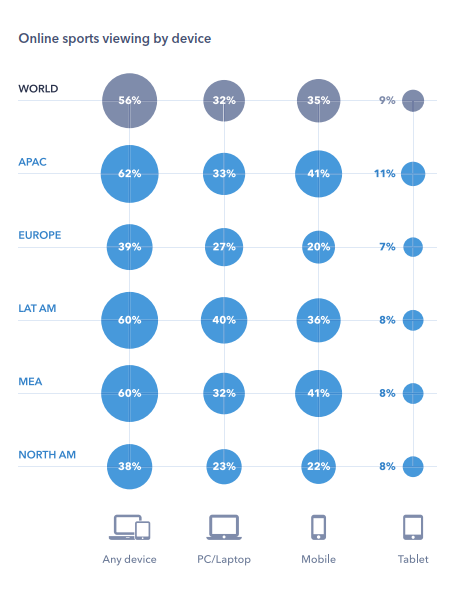The Game is Changing
The traditional broadcast interface between sport and its fans is undergoing a generational shift. No longer do we sink into the armchair at home, turn on the TV and watch a match or game from start to finish. We live stream AFL and NRL games to our phones while camping (or at dinner with the in-laws).
We consume English Premier League highlights packages on the commute. Golf fanatics will soon be able to log on to GolfTV and follow the round of a single player rather than whoever the broadcaster chooses. Cycling fans can get an intimate view of what their favourite cyclists are going through.
Cashed up sports are also upping the game on viewer engagement. As fans watch multiple sports on multiple screens, intuitively benchmarking sports against each other in terms of the experiences they provide, sports like the NBA and the EPL are leading the way in terms of providing sophisticated, personalised and exclusive experiences.
Fans are willing to subscribe to content where they see value and, increasingly, the smart sports are augmenting their content with in-screen polling, betting, stats, expert breakdowns of the game and real-time graphical analysis. Platforms such as Vudoo, MIA, Second Spectrum and DOT Loves Data are the emerging enablers of this new value creating. And sports must engage with this new world or risk falling by the wayside.
The emergence of Over The Top (OTT) broadcasting is also starting to rattle the cage of traditional broadcasters by allowing sports to stream direct to the viewer in the same way that Netflix, Stan or Hulu do for drama. As the relationship with each fan becomes an important driver of revenue, many clubs and leagues are realising that it’s far better to control the content, the distribution and hence the relationship, in-house. Sports can now index their content according to the value of each fan and “own” them more readily in an ever more crowded marketplace.
OTT runs the gamut from large, existing providers such as Amazon, Youtube and Facebook (Amazon, for example, has been paying about $65 million to stream NFL Thursday Night Games on its Prime Video app since 2017. Facebook recently won the right to be the exclusive International Cricket Council digital content partner up to 2023, giving it rights to share clips from ICC events on Facebook, WhatsApp and Instagram) – to start ups such as OTT platform, YuppTV. In addition to global digital broadcast rights to the Indian Premier League, YuppTV recently gained non-exclusive broadcast rights for India’s home cricket matches outside India, tapping into to the 31 million strong global Indian diaspora.
Smaller sports are also taking advantage of the OTT possibilities, with the World Surf League (WSL) and Ironman streaming their competitions via Facebook. (The WSL has 7 million likes and Facebook says that 3.5 million people watched at least one minute of an Ironman event on Facebook in 2018.)
Formula 1, meanwhile, has opened up its own direct OTT channel to capture revenue opportunities from hardcore fans, “super-serving” unique behind the scenes content, archival content and live footage from 24 different feeds on the track.
At the same time that the connections between fans and clubs, leagues and rights holders are changing, the business-as-usual economics of sports is being upended. Sports and entertainment cable subscriptions and bundles are being disrupted, bringing downward pressure on the value of new broadcast deals.
Combined with falling participation rates in some sports, and sponsors stressing the need to derive a more commercial return on their investment in sport, some sports organisations are staring into a revenue hole.
As this upheaval washes through the sports broadcast space, most of the commentary has focussed on how the codes, especially the larger codes in each country, are going to negotiate their next rights deal. Alongside the question of money, there’s arguably a bigger question at play: how should each sport reassess and transform their capabilities to future-proof their revenue streams – and ultimately their survival?



